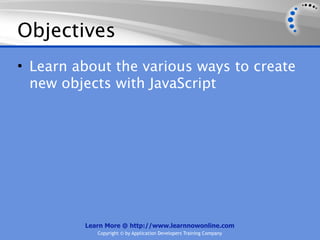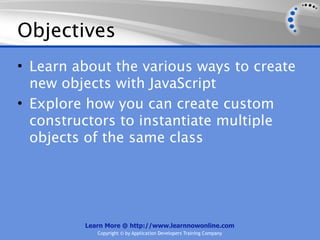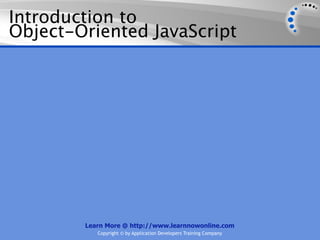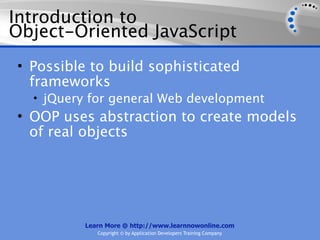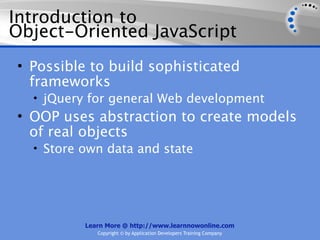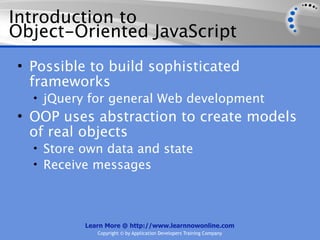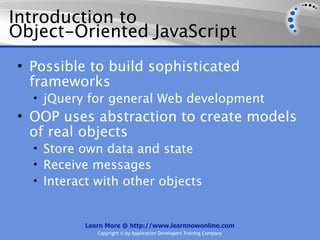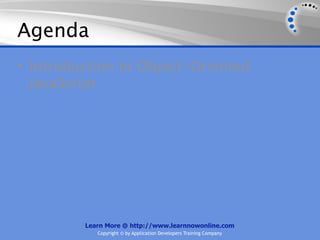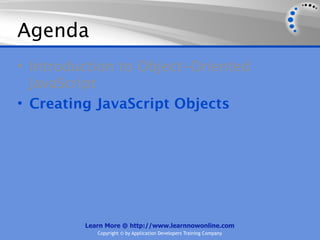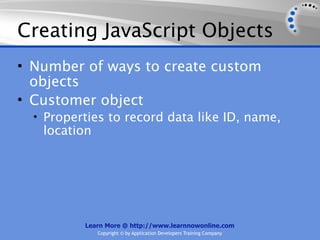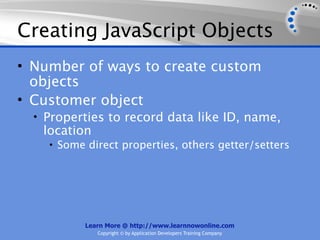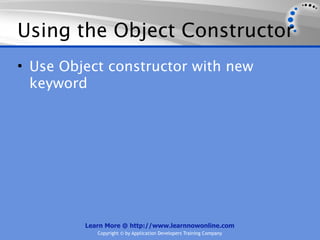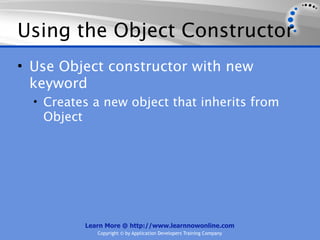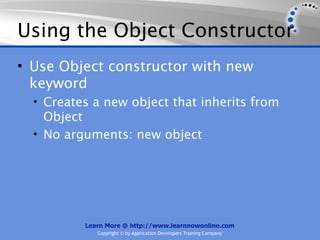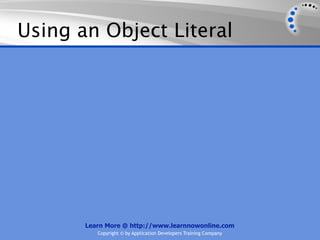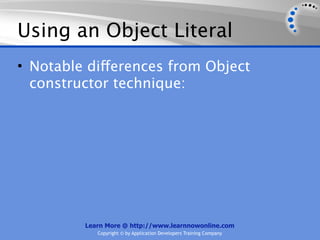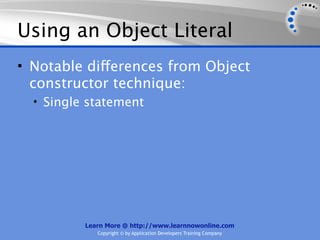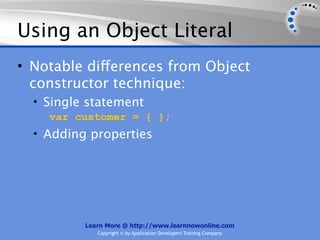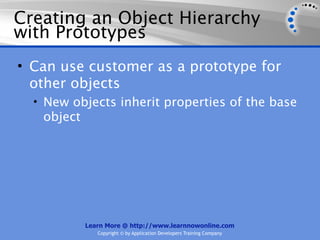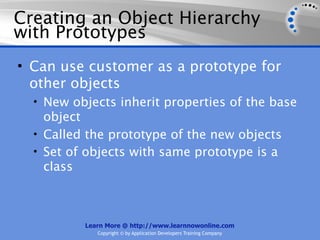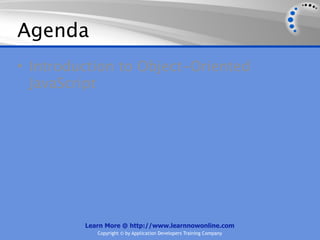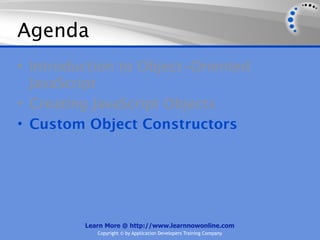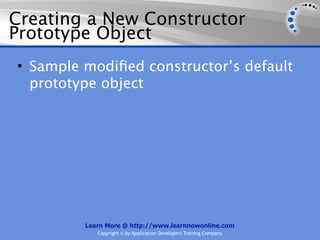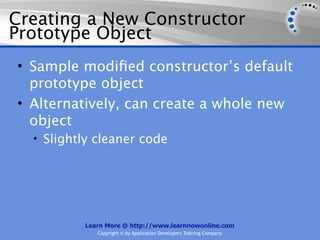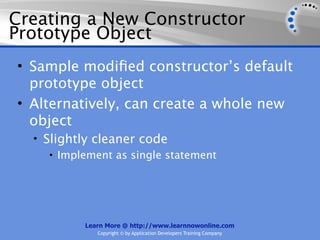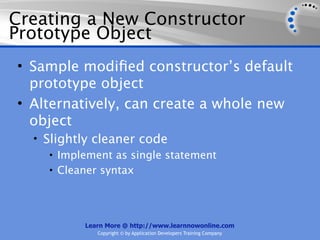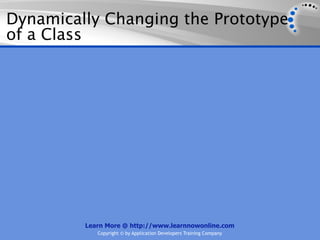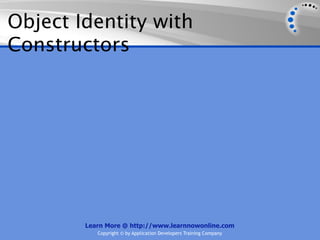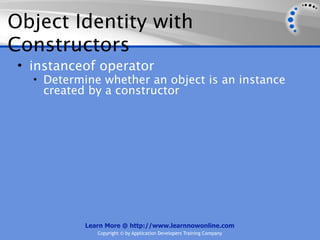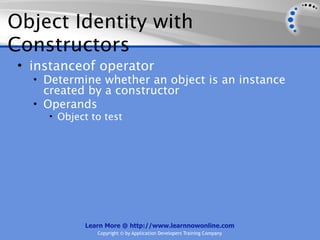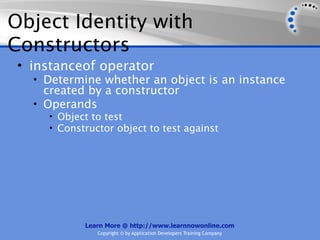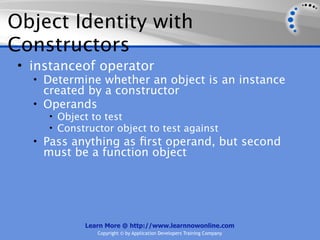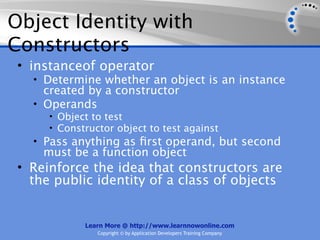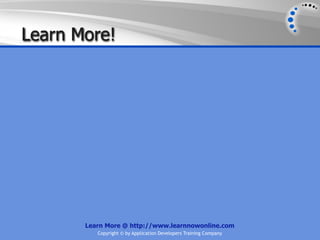Object-Oriented JavaScript
- 1. Object-Oriented JavaScript Learn More @ http://www.learnnowonline.com Copyright © by Application Developers Training Company
- 2. Objectives Learn More @ http://www.learnnowonline.com Copyright © by Application Developers Training Company
- 3. Objectives • Learn about the various ways to create new objects with JavaScript Learn More @ http://www.learnnowonline.com Copyright © by Application Developers Training Company
- 4. Objectives • Learn about the various ways to create new objects with JavaScript • Explore how you can create custom constructors to instantiate multiple objects of the same class Learn More @ http://www.learnnowonline.com Copyright © by Application Developers Training Company
- 5. Introduction to Object-Oriented JavaScript Learn More @ http://www.learnnowonline.com Copyright © by Application Developers Training Company
- 6. Introduction to Object-Oriented JavaScript • Possible to build sophisticated frameworks Learn More @ http://www.learnnowonline.com Copyright © by Application Developers Training Company
- 7. Introduction to Object-Oriented JavaScript • Possible to build sophisticated frameworks • jQuery for general Web development Learn More @ http://www.learnnowonline.com Copyright © by Application Developers Training Company
- 8. Introduction to Object-Oriented JavaScript • Possible to build sophisticated frameworks • jQuery for general Web development • OOP uses abstraction to create models of real objects Learn More @ http://www.learnnowonline.com Copyright © by Application Developers Training Company
- 9. Introduction to Object-Oriented JavaScript • Possible to build sophisticated frameworks • jQuery for general Web development • OOP uses abstraction to create models of real objects • Store own data and state Learn More @ http://www.learnnowonline.com Copyright © by Application Developers Training Company
- 10. Introduction to Object-Oriented JavaScript • Possible to build sophisticated frameworks • jQuery for general Web development • OOP uses abstraction to create models of real objects • Store own data and state • Receive messages Learn More @ http://www.learnnowonline.com Copyright © by Application Developers Training Company
- 11. Introduction to Object-Oriented JavaScript • Possible to build sophisticated frameworks • jQuery for general Web development • OOP uses abstraction to create models of real objects • Store own data and state • Receive messages • Interact with other objects Learn More @ http://www.learnnowonline.com Copyright © by Application Developers Training Company
- 12. Agenda Learn More @ http://www.learnnowonline.com Copyright © by Application Developers Training Company
- 13. Agenda • Introduction to Object-Oriented JavaScript Learn More @ http://www.learnnowonline.com Copyright © by Application Developers Training Company
- 14. Agenda • Introduction to Object-Oriented JavaScript • Creating JavaScript Objects Learn More @ http://www.learnnowonline.com Copyright © by Application Developers Training Company
- 15. Agenda • Introduction to Object-Oriented JavaScript • Creating JavaScript Objects • Custom Object Constructors Learn More @ http://www.learnnowonline.com Copyright © by Application Developers Training Company
- 16. Creating JavaScript Objects Learn More @ http://www.learnnowonline.com Copyright © by Application Developers Training Company
- 17. Creating JavaScript Objects • Number of ways to create custom objects Learn More @ http://www.learnnowonline.com Copyright © by Application Developers Training Company
- 18. Creating JavaScript Objects • Number of ways to create custom objects • Customer object Learn More @ http://www.learnnowonline.com Copyright © by Application Developers Training Company
- 19. Creating JavaScript Objects • Number of ways to create custom objects • Customer object • Properties to record data like ID, name, location Learn More @ http://www.learnnowonline.com Copyright © by Application Developers Training Company
- 20. Creating JavaScript Objects • Number of ways to create custom objects • Customer object • Properties to record data like ID, name, location • Some direct properties, others getter/setters Learn More @ http://www.learnnowonline.com Copyright © by Application Developers Training Company
- 21. Creating JavaScript Objects • Number of ways to create custom objects • Customer object • Properties to record data like ID, name, location • Some direct properties, others getter/setters • Override Object.toString Learn More @ http://www.learnnowonline.com Copyright © by Application Developers Training Company
- 22. Creating JavaScript Objects • Number of ways to create custom objects • Customer object • Properties to record data like ID, name, location • Some direct properties, others getter/setters • Override Object.toString • Method to record sales Learn More @ http://www.learnnowonline.com Copyright © by Application Developers Training Company
- 23. Using the Object Constructor Learn More @ http://www.learnnowonline.com Copyright © by Application Developers Training Company
- 24. Using the Object Constructor • Use Object constructor with new keyword Learn More @ http://www.learnnowonline.com Copyright © by Application Developers Training Company
- 25. Using the Object Constructor • Use Object constructor with new keyword • Creates a new object that inherits from Object Learn More @ http://www.learnnowonline.com Copyright © by Application Developers Training Company
- 26. Using the Object Constructor • Use Object constructor with new keyword • Creates a new object that inherits from Object • No arguments: new object Learn More @ http://www.learnnowonline.com Copyright © by Application Developers Training Company
- 27. Using the Object Constructor • Use Object constructor with new keyword • Creates a new object that inherits from Object • No arguments: new object • Primitive type argument: create new Number, Boolean, or String object Learn More @ http://www.learnnowonline.com Copyright © by Application Developers Training Company
- 28. Using an Object Literal Learn More @ http://www.learnnowonline.com Copyright © by Application Developers Training Company
- 29. Using an Object Literal • Notable differences from Object constructor technique: Learn More @ http://www.learnnowonline.com Copyright © by Application Developers Training Company
- 30. Using an Object Literal • Notable differences from Object constructor technique: • Single statement Learn More @ http://www.learnnowonline.com Copyright © by Application Developers Training Company
- 31. Using an Object Literal • Notable differences from Object constructor technique: • Single statement var customer = { }; Learn More @ http://www.learnnowonline.com Copyright © by Application Developers Training Company
- 32. Using an Object Literal • Notable differences from Object constructor technique: • Single statement var customer = { }; • Adding properties Learn More @ http://www.learnnowonline.com Copyright © by Application Developers Training Company
- 33. Using an Object Literal • Notable differences from Object constructor technique: • Single statement var customer = { }; • Adding properties • Defining getters and setters Learn More @ http://www.learnnowonline.com Copyright © by Application Developers Training Company
- 34. Creating an Object Hierarchy with Prototypes Learn More @ http://www.learnnowonline.com Copyright © by Application Developers Training Company
- 35. Creating an Object Hierarchy with Prototypes • Can use customer as a prototype for other objects Learn More @ http://www.learnnowonline.com Copyright © by Application Developers Training Company
- 36. Creating an Object Hierarchy with Prototypes • Can use customer as a prototype for other objects • New objects inherit properties of the base object Learn More @ http://www.learnnowonline.com Copyright © by Application Developers Training Company
- 37. Creating an Object Hierarchy with Prototypes • Can use customer as a prototype for other objects • New objects inherit properties of the base object • Called the prototype of the new objects Learn More @ http://www.learnnowonline.com Copyright © by Application Developers Training Company
- 38. Creating an Object Hierarchy with Prototypes • Can use customer as a prototype for other objects • New objects inherit properties of the base object • Called the prototype of the new objects • Set of objects with same prototype is a class Learn More @ http://www.learnnowonline.com Copyright © by Application Developers Training Company
- 39. Object Identity Learn More @ http://www.learnnowonline.com Copyright © by Application Developers Training Company
- 40. Object Identity • Can use the isPrototypeOf method Learn More @ http://www.learnnowonline.com Copyright © by Application Developers Training Company
- 41. Object Identity • Can use the isPrototypeOf method • See whether one object has another as its prototype Learn More @ http://www.learnnowonline.com Copyright © by Application Developers Training Company
- 42. Agenda Learn More @ http://www.learnnowonline.com Copyright © by Application Developers Training Company
- 43. Agenda • Introduction to Object-Oriented JavaScript Learn More @ http://www.learnnowonline.com Copyright © by Application Developers Training Company
- 44. Agenda • Introduction to Object-Oriented JavaScript • Creating JavaScript Objects Learn More @ http://www.learnnowonline.com Copyright © by Application Developers Training Company
- 45. Agenda • Introduction to Object-Oriented JavaScript • Creating JavaScript Objects • Custom Object Constructors Learn More @ http://www.learnnowonline.com Copyright © by Application Developers Training Company
- 46. Custom Object Constructors Learn More @ http://www.learnnowonline.com Copyright © by Application Developers Training Company
- 47. Custom Object Constructors • Constructor is a function that initializes an object Learn More @ http://www.learnnowonline.com Copyright © by Application Developers Training Company
- 48. Custom Object Constructors • Constructor is a function that initializes an object • Used with the new keyword Learn More @ http://www.learnnowonline.com Copyright © by Application Developers Training Company
- 49. Custom Object Constructors • Constructor is a function that initializes an object • Used with the new keyword • This actually creates the object Learn More @ http://www.learnnowonline.com Copyright © by Application Developers Training Company
- 50. Custom Object Constructors • Constructor is a function that initializes an object • Used with the new keyword • This actually creates the object • Constructor’s prototype object becomes prototype of new object Learn More @ http://www.learnnowonline.com Copyright © by Application Developers Training Company
- 51. Custom Object Constructors • Constructor is a function that initializes an object • Used with the new keyword • This actually creates the object • Constructor’s prototype object becomes prototype of new object • So all objects created with the constructor share prototypes Learn More @ http://www.learnnowonline.com Copyright © by Application Developers Training Company
- 52. Custom Object Constructors • Constructor is a function that initializes an object • Used with the new keyword • This actually creates the object • Constructor’s prototype object becomes prototype of new object • So all objects created with the constructor share prototypes • So all are members of the same class Learn More @ http://www.learnnowonline.com Copyright © by Application Developers Training Company
- 53. Creating a New Constructor Prototype Object Learn More @ http://www.learnnowonline.com Copyright © by Application Developers Training Company
- 54. Creating a New Constructor Prototype Object • Sample modified constructor’s default prototype object Learn More @ http://www.learnnowonline.com Copyright © by Application Developers Training Company
- 55. Creating a New Constructor Prototype Object • Sample modified constructor’s default prototype object • Alternatively, can create a whole new object Learn More @ http://www.learnnowonline.com Copyright © by Application Developers Training Company
- 56. Creating a New Constructor Prototype Object • Sample modified constructor’s default prototype object • Alternatively, can create a whole new object • Slightly cleaner code Learn More @ http://www.learnnowonline.com Copyright © by Application Developers Training Company
- 57. Creating a New Constructor Prototype Object • Sample modified constructor’s default prototype object • Alternatively, can create a whole new object • Slightly cleaner code • Implement as single statement Learn More @ http://www.learnnowonline.com Copyright © by Application Developers Training Company
- 58. Creating a New Constructor Prototype Object • Sample modified constructor’s default prototype object • Alternatively, can create a whole new object • Slightly cleaner code • Implement as single statement • Cleaner syntax Learn More @ http://www.learnnowonline.com Copyright © by Application Developers Training Company
- 59. Dynamically Changing the Prototype of a Class Learn More @ http://www.learnnowonline.com Copyright © by Application Developers Training Company
- 60. Dynamically Changing the Prototype of a Class • Benefit of using a prototype is you can dynamically change it Learn More @ http://www.learnnowonline.com Copyright © by Application Developers Training Company
- 61. Dynamically Changing the Prototype of a Class • Benefit of using a prototype is you can dynamically change it • Automatically changes all objects in the class Learn More @ http://www.learnnowonline.com Copyright © by Application Developers Training Company
- 62. Dynamically Changing the Prototype of a Class • Benefit of using a prototype is you can dynamically change it • Automatically changes all objects in the class • Object inherits from prototype even when prototype subsequently changes Learn More @ http://www.learnnowonline.com Copyright © by Application Developers Training Company
- 63. Dynamically Changing the Prototype of a Class • Benefit of using a prototype is you can dynamically change it • Automatically changes all objects in the class • Object inherits from prototype even when prototype subsequently changes • Can even modify prototypes of built-in objects Learn More @ http://www.learnnowonline.com Copyright © by Application Developers Training Company
- 64. Object Identity with Constructors Learn More @ http://www.learnnowonline.com Copyright © by Application Developers Training Company
- 65. Object Identity with Constructors • instanceof operator Learn More @ http://www.learnnowonline.com Copyright © by Application Developers Training Company
- 66. Object Identity with Constructors • instanceof operator • Determine whether an object is an instance created by a constructor Learn More @ http://www.learnnowonline.com Copyright © by Application Developers Training Company
- 67. Object Identity with Constructors • instanceof operator • Determine whether an object is an instance created by a constructor • Operands Learn More @ http://www.learnnowonline.com Copyright © by Application Developers Training Company
- 68. Object Identity with Constructors • instanceof operator • Determine whether an object is an instance created by a constructor • Operands • Object to test Learn More @ http://www.learnnowonline.com Copyright © by Application Developers Training Company
- 69. Object Identity with Constructors • instanceof operator • Determine whether an object is an instance created by a constructor • Operands • Object to test • Constructor object to test against Learn More @ http://www.learnnowonline.com Copyright © by Application Developers Training Company
- 70. Object Identity with Constructors • instanceof operator • Determine whether an object is an instance created by a constructor • Operands • Object to test • Constructor object to test against • Pass anything as first operand, but second must be a function object Learn More @ http://www.learnnowonline.com Copyright © by Application Developers Training Company
- 71. Object Identity with Constructors • instanceof operator • Determine whether an object is an instance created by a constructor • Operands • Object to test • Constructor object to test against • Pass anything as first operand, but second must be a function object • Reinforce the idea that constructors are the public identity of a class of objects Learn More @ http://www.learnnowonline.com Copyright © by Application Developers Training Company
- 72. Learn More! Learn More @ http://www.learnnowonline.com Copyright © by Application Developers Training Company
- 73. Learn More! • This is an excerpt from a larger course. Visit www.learnnowonline.com for the full details! Learn More @ http://www.learnnowonline.com Copyright © by Application Developers Training Company
Editor's Notes
- #2: \n
- #3: \n
- #4: \n
- #5: \n
- #6: \n
- #7: \n
- #8: \n
- #9: \n
- #10: \n
- #11: \n
- #12: \n
- #13: \n
- #14: \n
- #15: \n
- #16: \n
- #17: \n
- #18: \n
- #19: \n
- #20: \n
- #21: \n
- #22: \n
- #23: \n
- #24: \n
- #25: DEMO – rest of section\n
- #26: DEMO – rest of section\n
- #27: DEMO – rest of section\n
- #28: DEMO – rest of section\n
- #29: DEMO – rest of section\n
- #30: DEMO – rest of section\n
- #31: DEMO – rest of section\n
- #32: DEMO – rest of section\n
- #33: DEMO – rest of section\n
- #34: DEMO – rest of section\n
- #35: DEMO – rest of section\n
- #36: DEMO – rest of section\n
- #37: DEMO – rest of section\n
- #38: \n
- #39: \n
- #40: \n
- #41: \n
- #42: \n
- #43: DEMO – Creating an Object Constructor section\n
- #44: DEMO – Creating an Object Constructor section\n
- #45: DEMO – Creating an Object Constructor section\n
- #46: DEMO – Creating an Object Constructor section\n
- #47: DEMO – Creating an Object Constructor section\n
- #48: DEMO – Creating an Object Constructor section\n
- #49: DEMO – rest of section\n
- #50: DEMO – rest of section\n
- #51: DEMO – rest of section\n
- #52: DEMO – rest of section\n
- #53: DEMO – rest of section\n
- #54: DEMO – rest of section\n
- #55: DEMO – rest of section\n
- #56: DEMO – rest of section\n
- #57: DEMO – rest of section\n
- #58: DEMO – rest of section\n
- #59: DEMO – rest of section\n
- #60: DEMO – rest of section\n
- #61: DEMO – rest of section\n
- #62: DEMO – rest of section\n
- #63: DEMO – rest of section\n
- #64: DEMO – rest of section\n
- #65: DEMO: rest of section\n



